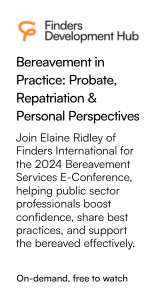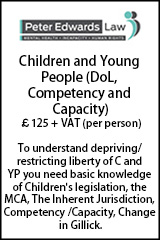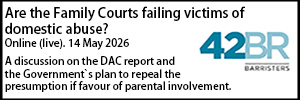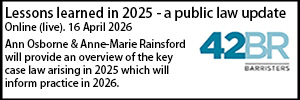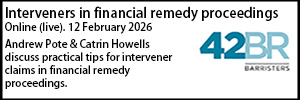Parental responsibility and the falsehood of paternity
- Details
Toby Craddock considers the lessons from two important cases where judges were called on to determine whether an unmarried man, who previously considered himself to be the children’s biological father, should lose parental responsibility after paternity testing was undertaken.
Parentage is an issue that frequently rears its head in both public and private law cases, and practitioners will be familiar with the approach taken by the Courts when genuine – or potentially bogus – doubts are raised as to paternity.
The testing which will invariably be directed can now be made available in days – not weeks – from accredited laboratories, so potentially life-altering decisions can be considered expeditiously, and the fundamental issue of a child’s parentage can be clarified as soon as possible.
The speed of those enquiries being made is perhaps the only consolation when the outcome of paternity testing confirms the biological fact the parties and the Court had been operating under was a falsehood i.e. that Mr. X and is not the biological father of the child.
The consequences for Mr. X and the child cannot be overstated, especially when a biological link is severed but their legal status remains unchanged. The complexities of this discrepancy can be highlighted in no less than three judgments handed down by two judges in two cases, which will be considered below. They are as follows:
- A Local Authority v SB & Ors [2022] EWFC 111 (15 July 2022)
- Re C&A (Children: Acquisition and discharge of parental responsibility by an unmarried father) [2023] EWHC 516 (9 March 2023)
- A Local Authority v SB & Ors [2023] EWFC 58 (23 March 2023)
The Facts
The facts considered by both judges are broadly the same. HHJ Case and HHJ Moradifar were both invited to determine whether an unmarried man, who previously considered himself to be the children’s biological father, should lose parental responsibility after paternity testing was undertaken and, if so, what proper approach should be employed by the Court when interpreting section 4(2A) of the Children Act 1989.
HHJ Case tackled the issue first in A Local Authority v SB & Ors [2022] before HHJ Moradifar reached a different conclusion less than a year later in Re C&A (Children: Acquisition and discharge of parental responsibility by an unmarried father) [2023].
Legal analysis
NB: Extracts from the judgments contain emphasis added by the author.
A Local Authority v SB & Ors [2022] EWFC 111 (15 July 2022)
The mother made an application for a declaration of non-parentage and to discharge the father’s parental responsibility within public law proceedings. HHJ Case made a declaration of non-parentage pursuant to s.55A Family Law Act 1986 at an interim stage noting that no party disputed the outcome of the paternity testing nor the making of a declaration. HHJ Case then went on to consider the mother’s second application:
10. The issue which has been exercising my mind in respect of this application over the last two or three hearings has been whether discharge of parental responsibility is an automatic consequence of the declaration of non-parentage or whether it is a separate welfarebased decision.
11. This question turns on the construction of section 4 of the Children Act 1989, and in particular subsection (2A), which provides, "A person who has acquired parental responsibility under subsection (1) shall cease to have that responsibility only if the court so orders".
HHJ Case was not assisted by settled law on this issue and made the following observation:
15. Crucially, however, there are no domestic cases that counsel or I have been able to identify dealing specifically with the situation of the unmarried man who has been named on the birth certificate as a father, but is subsequently found not to be such by DNA testing. On the face of it, this is surprising given how commonly such a situation must arise.
…
18. It seems to me that in these circumstances the appropriate approach is to view the question largely as one of pure statutory construction.
HHJ approached the construction of s.4(2A) as follows:
28. To my mind, one of the most important factors is that a declaration of non-paternity is a declaration of biological fact rather than a declaration as to legal status. Self-evidently an order under the Children Act 1989 section 4(2A) is the latter. The two orders being so different in character, I find it difficult to see how the order being referred to under section 4(2A) could be the declaration of non-paternity.
29. Secondly, there is the use of the word "only" in section 4 (2A),
"A person who has acquired parental responsibility under subsection (1) shall cease to have that responsibility only if the court so orders"
That seems to suggest that an order under subsection (2A) is the only route by which parental responsibility conferred under section 4(1) can be lost. Again, that appears to preclude the possibility of parental responsibility being lost following an order or a declaration made under a completely different piece of legislation.
30. Thirdly, there is the fact that the whole of section 4 of the Children Act 1989 is subject to the principle that the child's welfare is paramount. That was made clear by Ryder LJ in the case of Re D. It concerned a biological father, but nevertheless the point still stands.He said:
"When a court is considering an application relating to the cessation of parental responsibility, the court is considering a question with respect to the upbringing of a child with the consequence that by section 1(1)(b) of the Children Act 1989 the child's welfare will be the court's paramount consideration."
31. Ryder LJ goes on to say that there is no requirement to consider the welfare checklist, although the court may find it a useful analytical framework, not least because welfare has to be considered and reasoned. He also added that the cessation of parental responsibility is an order of the court, "Therefore the court must consider whether making such an order is better for the child than making no order at all".
32. It is clear, then, that the matters which the court will take into account when considering an application for discharge of parental responsibility are much wider than the predominantly factual matters which it will consider when dealing with an application for a declaration under the 1986 Act (notwithstanding the residual discretion referred to earlier).
HHJ Case subsequently determined that:
1. section (2A) is the only means by which the court can consider removing parental responsibility from a father who has gained it under subsection (1);
2. that it is a welfare-based decision;
3. that the fact that the man in question has been found not to be the biological father will feed into that welfare consideration, but that the discharge of parental responsibility is not automatic. The importance of the lack of a biological link is one which will vary from case to case.
HHJ Case therefore adjourned the mother’s application to allow all parties to address welfare considerations in their final evidence.
HHJ Moradifar was then confronted with the same issue some 8 months later. Unlike HHJ Case, he had the benefit of her analysis and referenced this in his judgment.
Re C&A (Children: Acquisition and discharge of parental responsibility by an unmarried father) [2023] EWHC 516 (9 March 2023)
The local authority, the mother and the children’s guardian argued that a declaration on non-parentage would rebut the presumption of paternity which had incorrectly granted the father parental responsibility under s.4(1). The process of removing of the father’s name from the child’s birth certificate would be triggered and therefore result in his parental responsibility being discharged.
The father unsurprisingly preferred the analysis of HHJ Case and invited the Court to conduct a welfare analysis before determining the mother’s applications.
HHJ Moradifar departed from HHJ Case’s approach for the following reasons:
Firstly, HHJ Moradifar identified that s.4(1) of the Children Act 1989 was intended to confer parental responsibility on biological fathers correctly named on a birth certificate:
13. In my judgment, the biological link is the foundation that identifies a man as the father of the child under the aforementioned statutory regime. When that foundation is displaced, the status of that man as the 'father' cannot persist.
In light of this, HHJ Moradifar disagreed section (2A) required a welfare analysis to be undertaken:
15. Where the very legal presumption for the acquisition of parental responsibility by operation of law under s. 4(1) does not exist, any welfare analysis is superfluous and would serve no purpose at all.
Finally, and most importantly, HHJ Moradifar does not say that the declaration of non-parentage automatically discharges parental responsibility akin to rendering it void ab initio.
15. I agree with Mr Kirkwood's sagacious submissions that it would be contrary to public policy and the intentions of parliament to conclude that in such circumstances parental responsibly ceases ab initio. Therefore, this raises the argument that a declaration of 'nonparentage' and a subsequent re-registration is all that is required for N to cease to have parental responsibly for C. There is an inherent attraction and neatness to this argument. However, in my judgment, this cannot survive the provision of s.4(2A) of the Act. Its terms are clear by stating that a court order is required. In my judgment it would also be good practice to be clear that parental responsibility has ceased by reference to a particular date’.
HHJ Moradifar therefore granted the mother’s application and discharged parental responsibility from the date of his judgment.
A Local Authority v SB & Ors [2023] EWFC 58 (23 March 2023)
Two weeks later, HHJ Case handed down a second judgment in A Local Authority v SB & Ors. The care proceedings where the mother had previously made her application to discharge the father’s parental responsibility were due to finalise and the parties had subsequently received HHJ Moradifar’s judgment. HHJ Case had to consider whether she was now bound by the decision, as HHJ Moradifar had been sitting as a Judge of the High Court at the time pursuant to s.9 of the Senior Courts Act 1981.
HHJ Case did not consider she was bound by his decision and noted that HHJ Moradifar failed to consider Re D (withdrawal of parental responsibility) and the leading judgment of Ryder LJ, which constituted a higher authority. [1]
HHJ Case maintained that ‘[an] application relating to the cessation of parental responsibility is a question with respect to the upbringing of a child. Indeed, having regard to Ryder LJ's reasoning, one might even say that an order terminating parental responsibility is the quintessential question with respect to the upbringing of a child. It is an overarching decision which alters the composition of the small group of adults in a child’s life who are charged with all decision making for the child, save for any decision which is directly determined by the court.’ [2]
Accordingly, HHJ Case found it impossible ‘[to] reconcile these words… with the conclusion reached by HHJ Moradifar that an order discharging parental responsibility should automatically follow from a declaration of non-parentage.’ [3]
HHJ Case applied the welfare checklist at the conclusion of her judgment and ultimately discharged Mr. X’s parental responsibility. Of course, the outcome would have been identical if HHJ Moradifar’s approach had been deployed instead.
Guidance for Practitioners
HHJ Case and HHJ Moradifar agreed on the fundamental principles to be applied. Namely:
- Acquisition of parental responsibility under s.4(1) is based on the rebuttable presumption that he is the biological father of the child.
- If that presumption is rebutted, then the foundation for the acquired parental responsibility is displaced.
- An order should be made when discharging a man’s parental responsibility under s.4(2A) rather than simply relying upon a declaration of non-parentage.
But should a welfare-based decision be undertaken prior to discharge? I do not consider it should.
Although I agree with HHJ Case that automatically extinguishing the legal status of non-biological fathers is a question with respect to the upbringing of a child, I respectfully disagree that a welfare-based decision could properly conclude that parental responsibility is retained when it was originally acquired through mistake or deception.
Assuming the welfare analysis results in the child’s non-biological father retaining parental responsibility for them, then they would have a birth certificate with no mention of a man who holds parental responsibility for them and there would be no order discharging that man as a holder of parental responsibility. His legal status would exist outside of the statutory scheme. Could that be said to be in any child’s best interests?
Toby Craddock is a barrister at Deans Court Chambers.
[1] [2014] EWCA Civ 315.
[2] A Local Authority v SB & Ors [2023] EWFC 58, §53
[3] Ibid, §58.

























